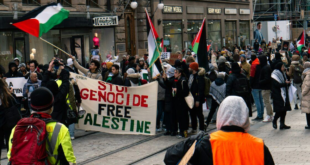Israel ended its military presence in the Gaza Strip on Monday, having removed 8,500 Jewish settlers from 21 enclaves and demolished their homes after 38 years of occupation.
Following is an outline of Israel’s first handover of an entire territory that it captured in the 1967 Middle East war and which Palestinians want for a state, as well as issues critical to Gaza’s future.
How did the pullout unfold?
Israel’s army completed its pullout less than 24 hours after Prime Minister Ariel Sharon’s Cabinet gave final approval. Jubilant Palestinians rushed into the abandoned settlements, planting flags in the rubble and firing in the air. The Cabinet, under pressure from leading rabbis, made a last-minute decision to leave settlers’ synagogues standing, and Palestinian youths targeting symbols of the occupation set several of them ablaze.
Official Palestinian Authority festivities are expected to compete with gun-toting rallies of factions who have claimed credit for the pullout and eroded President Mahmoud Abbas grip on power. There are fears of property seizures by armed gangs.
Will Gaza be peaceful after pullout?
Abbas has begun revamping a security apparatus plagued by corruption, a lack of clear lines of authority, poor motivation and factional gangs.
However, reforms have been tentative and resistance strong. Lawlessness was highlighted days before the pullout by the killing of Gaza’s ex-security chief in a brazen pre-dawn raid by gunmen on his walled family compound.
Islamists have gained de facto power in wide areas. Gaza political analyst and human-rights activist Eyad Al Sarraj has warned the territory “could go the way of Somalia.”
Can Gaza’s economy get off the ground?
Not unless Israel eases its grip on land, sea and air approaches to Gaza. The Jewish state says this could happen but on condition Abbas instils order in Gaza. Palestinians say isolation has caused economic meltdown and bred violence.
Egyptian special police were replacing Israeli troops along Gaza’s border with Egypt to prevent gun-running to factions. However, Israel says it will keep control of crossings with Egypt for at least six more months and perhaps yield to third-party monitoring afterwards.
Israel says Gaza can build a seaport and is open to a road or rail corridor between Gaza and the West Bank. However, it plans to keep control over Gaza’s sea lanes and airspace and so far rules out allowing Gaza to reopen its airport.
Will pullout lead to roadmap peace-making?
Unlikely, at least until after Israeli and Palestinian general elections next year. Israel rules out US-sponsored roadmap talks on Palestinian statehood without the dissolution of groups.
Palestinian officials agree bloodshed should stop, but not to disarmament without assurances of a viable state through talks. They fear such prospects are fading as Israel keeps expanding larger West Bank settlements.
Diplomatic deadlock after the pullout could rekindle Palestinian revolt. Palestinians are angry over a barrier Israel is building that cuts into occupied West Bank land. Israel says it keeps out suicide bombers. Palestinians call it a land grab.
Only tough US intervention might produce compromise on a basis for talks, but a final peace deal looks far off.
Will withdrawal boost Abbas?
Abbas, seen as a moderate favouring peaceful co-existence with Israel, will gain leverage over factions if the pullout pacifies Palestinian areas, gives Gaza access to the outside world to develop its economy and spurs the “road map” process.
All could help Abbas Fateh movement deflect a looming electoral challenge by Islamist Hamas. Otherwise, turmoil could worsen and stymie or even topple Abbas.
 Eurasia Press & News
Eurasia Press & News

